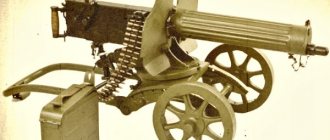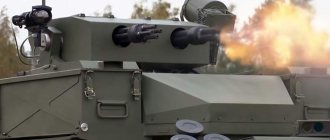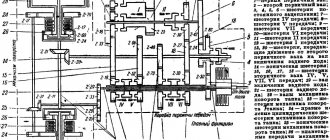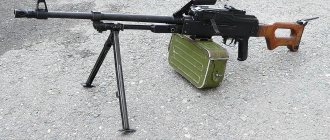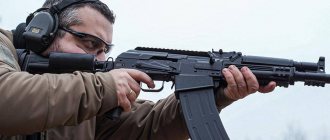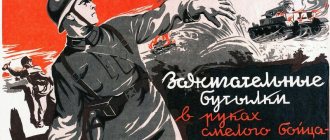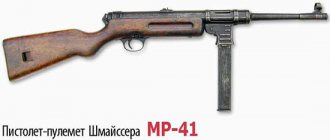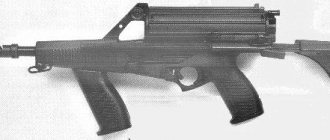One of the first designers of the Soviet Union who seriously began creating light machine guns was Vasily Degtyarev. The experience gained while working in the design bureau of automatic small arms, organized by the famous Soviet designer Vladimir Fedorov at the Kovrov arms factory, allowed Degtyarev to begin developing a light machine gun already in 1923.
In 1926, the current model of the Degtyarev system machine gun, designed to use a 7.62 x 54 mm rifle cartridge, was submitted for testing, during which it showed excellent firing characteristics.
By 1945, the DP-27 was firmly in third place in terms of mass production after the Mosin rifle and PPSh-41.
- Type: Light machine gun
- Designer: V. A. Degtyarev
- Country: USSR
Design and principle of operation
The automatic operation of the machine gun was built according to a scheme that used the energy of powder gases removed from the barrel; locking was carried out by spreading the combat larvae to the sides. The gas regulator installed in the automation system created additional advantages when working in conditions of pollution, dust and extreme temperatures. The striker-type trigger mechanism allowed firing only in bursts. However, even a poorly trained fighter easily cut off bursts of 3-5 shots.
The successful layout of the automatic mechanisms, the use of a sliding bolt and direct supply of cartridges from the magazine made it possible to significantly reduce the size of the receiver compared to other machine guns of that time.
Adoption
At the beginning of 1927, the machine gun was adopted by the Red Army under the name DP-27 (“Degtyarev infantry model 1927”). In making this decision, members of the state commission noted the high survivability of the machine gun’s mechanisms (more than 70,000 shots were fired against the standard of 10,000), the simplicity and high manufacturability of its design: the production of the DP-27 required almost half the time than a similar foreign machine gun sample. According to some reports, by October 1, 1938, more than 8,000 units had been delivered to the Red Army units.
The DP-27 light machine gun immediately received high praise among the troops and soon became the main type of automatic weapon in rifle squads.
Characteristics
The range of a direct shot at the chest figure is 365 m. Fire at air targets is carried out at a distance of up to 500 m. The bullet retains its lethal effect at a distance of up to 1.5 km.
Combat rate of fire is up to 150 rounds per minute. Intensive burst fire without barrel cooling is possible up to 300 rounds.
Requirements for normal single combat for RPD:
- all four holes fit into a circle with a diameter of 15 cm;
- the average point of impact deviates from the control point by no more than 5 cm in any direction.
Requirements for normal burst combat for RPD:
- at least six holes out of eight fit into a circle with a diameter of 20 cm;
- the average point of impact deviates from the control point by no more than 5 cm in any direction.
The battle is checked by shooting at a black rectangle 35 cm high and 25 cm wide, mounted on a white shield 1 m high and 0.5 m wide. Firing range - 100 m, position - lying on a flat platform, cartridges - with an ordinary bullet, sight - 3, rear sight - 0.
Bullet dispersion when firing from a RPD reduced to normal combat:
| Firing range, m | Median deviations in height, cm | Median deviations in width, cm | Core stripes in height, cm | Core stripes width, cm | Bullet energy, J |
| 100 | 5 | 5 | 15 | 15 | 1618 |
| 200 | 10 | 9 | 30 | 30 | 1226 |
| 300 | 15 | 14 | 46 | 45 | 932 |
| 400 | 20 | 19 | 63 | 61 | 716 |
| 500 | 26 | 25 | 81 | 78 | 559 |
| 600 | 32 | 31 | 100 | 96 | 441 |
| 700 | 39 | 37 | 120 | 114 | 353 |
| 800 | 46 | 43 | 142 | 133 | 304 |
| 900 | 54 | 49 | 167 | 152 | 265 |
| 1000 | 63 | 55 | 195 | 172 | 235 |
Where the median deviation is half the width of the central dispersion band, containing 50% of all hits, and the core band is the dispersion band, containing 70% of the hits. When two core stripes intersect (in height and width), a scattering core is formed - a rectangle that includes the best, most dense half of all meeting points.
On the ground and in the air
The high tactical and technical characteristics and versatility of the design of the light machine gun of the Degtyarev system made it possible to create a number of specialized machine guns on its basis. In 1928, a 7.62-mm aircraft machine gun of the Degtyarev system - DA (Degtyarev Aviation) was developed and entered into service with the military air units of the USSR, and two years later the double-barreled aircraft machine gun DA-2 (in a coaxial version) appeared. . In 1929, the 7.62-mm tank machine gun of the Degtyarev system was adopted by the Red Army under the name DT (“Degtyarev Tank”), which was widely used on tanks and armored vehicles during the Second World War.
At the time of adoption, the DP-27 light machine gun (excluding the magazine) had the minimum weight among all domestic and foreign analogues known at that time. However, the weight of the loaded magazine reached 2800 g (unloaded weight was about 1650 g), and this brought the total weight of the DP-27 to 11,200 g, which was clearly excessive for a light machine gun.
Attachments for sniping
After the end of the Great Patriotic War, experiments were carried out in the USSR to create curved attachments for firing from cover, primarily for use by armored vehicle crews. The attachment was a curved barrel, in the breech of which was mounted a mechanism for attaching to the muzzle of the machine gun barrel. The length of the nozzle was 610 mm, the bending radius was 250 mm, and the bending angle was 90°. At the same time, the rifling of the curved barrel was a continuation of the rifling of the machine gun barrel. In addition, a similar barrel was tested, intended for installation on a machine gun instead of the standard one. However, tests have revealed that its characteristics are inferior to the nozzle.
Comments and suggestions
Although the machine gun proved to be quite maneuverable, light and durable, and in addition, it demonstrated reliability and was quickly brought into combat position, by the middle of the war it no longer met all the conditions of the battle. First of all, criticism was made regarding the bolt, recoil spring, magazine and bipod. For example, as experience of long-term operation in combat conditions has shown, individual parts of the bolt quickly wore out during intense shooting, which affected the reliability of the weapon. The service life of the recoil spring turned out to be short. At the same time, located under the barrel around the gas piston, it quickly heated up during operation. This caused her to sag and led to delays in firing. Suggestions were also expressed to increase the store's capacity. Among other things, the detachable bipod did not provide optimal stability to the weapon.
Company machine gun RP-46, created on the basis of a modernized light machine gun of the Degtyarev system (RP M). The machine gun was powered by a belt with 200 or 250 rounds of ammunition. However, with the belt feed unit removed, it was also possible to use disk magazines from the DP-27 (DPM) with 47 rounds
Degtyarev RPD light machine gun, 7.62 mm caliber cartridge. Device (9 photos)
Author: ZheKa
30 April 2022 12:20
Tags: firearms weapons weapons of all times Degtyarev machine gun
4212
9
In 1943, the Red Army's arsenal was replenished with the first domestic 7.62x39 mm intermediate cartridge. Soon after this, the development of new types of weapons designed to use such ammunition began.
0
See all photos in the gallery
The result of several programs to create new small arms was the emergence of a number of samples of different classes: the SKS self-loading carbine, the RPD light machine gun and other weapons. Thus, the “Degtyarev Light Machine Gun” became the first domestic model of its class to use the new intermediate cartridge. Even at the design stage of a new cartridge designed by N.M. Elizarova and B.V. Semin found that weapons for such ammunition would have noticeable advantages over existing systems, although in a number of cases lags in performance were expected. The cartridge was lighter, which affected the volume of carryable ammunition, but had a shorter firing range. Tests of the 7.62x39 mm cartridge showed its sufficient effectiveness when firing at distances up to 800 m. Analysis of battles, in turn, showed that such a firing range is quite sufficient for new weapons that will be used in future conflicts. At the beginning of 1944, a competition began to create a light machine gun chambered for an intermediate cartridge. The military wanted a relatively light weapon with the maximum possible firepower. In addition, the new model should not have the disadvantages inherent in the existing DP/DPM machine guns. Several leading gunsmith designers were involved in the development of competitive projects. S.G. presented his versions of the light machine gun. Simonov, F.V. Tokarev, A.I. Sudaev and other honored masters of their craft. In addition, V.A. took part in the competition. Degtyarev, several of whose machine guns have been in service with the Red Army since the late twenties. Using his experience in creating light machine guns, Degtyarev proposed several options for new weapons. Having similar gas automatics, the proposed projects differed in the design of the shutter and the ammunition supply system. Initially, Degtyarev proposed using a disk magazine similar to that used on the DP machine gun, and also considered the possibility of creating a detachable box magazine. However, an analysis of various proposals showed that the best option would be to use belt feeding. According to the results of tests carried out in mid-1944, the leader of the competition was the Degtyarev machine gun under the symbol RP-44. This weapon was even produced in a small batch and sent to the troops for testing at the front. Military tests ended with the development of proposals for fine-tuning and new requirements for weapons. The developer was required to correct the identified deficiencies and complete the development of the machine gun. Based on the results of tests by the troops, some changes were made to the design of the RP-44 machine gun. In this form, the weapon was again sent for testing and received a recommendation for adoption. A new model entered mass production under the name “Degtyarev light machine gun mod. 1944" or RPD. The designation RPD-44 is also sometimes found. Thanks to its adoption and the start of production, the RPD machine gun became one of the first production types of weapons designed to use the 7.62x39 mm cartridge. The RPD machine gun was built on the basis of gas automatics with a long piston stroke. The general automation scheme was partially borrowed from later modifications of the DP machine gun. In particular, to improve some characteristics, a gas regulator was introduced into the automation, which made it possible to change the amount of powder gases supplied to the piston. The design of the regulator included three so-called grooves for gas removal, numbered from “1” to “3”. Under normal conditions, the regulator should have been set to position “2”, which ensured normal operation of the automation. Groove No. 3 had a larger cross-section and was intended for firing when the weapon was dirty. Groove No. 1, in turn, had a minimum diameter and made it possible to reduce the rate of fire. Despite similar solutions and some borrowings, the RPD machine gun was seriously different from the DP and DPM. Thus, the receiver of the new weapon was developed from scratch. It consisted of a main lower part and a hinged upper cover. In addition, the rear part of the receiver was made in the form of a so-called. trigger frame, on which parts of the trigger mechanism, fire control handle and butt were attached. Inside the receiver there was a bolt group. In the front wall of the box, fastenings were provided for installing the barrel and gas piston tube. A curious feature of the RPD machine gun was its non-replaceable barrel. Operating experience with existing light machine guns showed that firing in short bursts allows the machine gunner to shoot all the ammunition he carries without overheating the barrel. Thus, the detachable barrel did not provide any noticeable advantages, but made the weapon more complicated and heavier. The need to carry a spare barrel also did not add convenience in battle. The barrel locking system using diverging lugs was similar to a similar unit on the DP machine gun, but had some differences. The bolt frame connected to the gas piston was in contact with a massive metal bolt. The latter had a central square-section channel for the striker and two deep grooves on the side surfaces. The latter contained combat stops mounted on axles. The return spring was located in the rear of the receiver and inside the metal part of the butt. When the bolt frame moved forward under the action of a spring, the bolt had to send the cartridge into the chamber. After stopping the bolt in the extreme forward position, the frame continued to move the firing pin. Moving forward, he pushed the lugs apart and they entered the grooves of the receiver, blocking the movement of the bolt. Further movement of the striker led to a shot. The pressure of the powder gases leaving the barrel through the gas outlet moved the piston and bolt frame. This caused the firing pin to move back and allow the stops to move out of place. Using shaped cutouts on the receiver, the stops returned to the neutral position and allowed the bolt to move back. The moving bolt captured the spent cartridge case, pulled it out of the chamber and brought it to the ejection window. The cartridge case was ejected through the windows in the receiver and bolt frame, downwards. When moving forward, the bolt frame, using a system of two levers, set the feeder in motion, which shifted the belt with the cartridge by one link, thereby bringing new ammunition onto the feed line.
0
The receiver of the RPD machine gun had a slot in the lower part of the right side, designed to remove the bolt handle. The handle was rigidly connected to the bolt frame and moved during shooting. The trigger mechanism of the RPD machine gun had a simple design and allowed firing only in bursts. When the trigger was pressed, the trigger lever and the sear moved, after which the bolt frame was unblocked, followed by a shot. The fire was fired from an open bolt. The design of the trigger included a non-automatic fuse. On the right surface of the receiver, above the trigger, there was a safety box. When the flag was in the forward position, the safety lock blocked the trigger lever; in the rear position, it allowed firing. For comfortable use, the Degtyarev machine gun was equipped with a wooden butt, pistol grip and forend. The butt was mounted on a metal base at the rear of the trigger frame. Also on the frame were mounts for a pistol grip fire control. The forend consisted of two wooden parts and metal spacers. It was fixed in front of the receiver. The unusual shape of the forend with two notches at the top and bottom was associated with the recommended shooting methods. When firing from the shoulder, the machine gunner had to support the weapon by the forend from below. Shooting “from the hip” was carried out using a belt. In this case, the belt redistributed the load on the shoulder, which made it possible to hold the fire control handle with one hand, and with the other to compensate for the recoil, holding the machine gun by the fore-end from above. The RPD machine gun was supposed to use cartridge belts, placed in metal boxes for convenience. In early versions of the project it was proposed to use belts for 100 and 200 rounds, equipped with round and square boxes, respectively. Later it was decided to abandon the 200-cartridge belt and the rather heavy square box. Serial RPD machine guns were equipped with collapsible cylindrical boxes for belts. Ammunition was supplied using a non-loose metal belt for 100 rounds, assembled from two parts. Machine gun with an open receiver cover. The upper part of the box was provided with a hinged cover and fastenings for installation on the machine gun. When preparing the weapon for firing, the box should have been mounted on a mount under the receiver. The top cover of the box was placed to the left of the machine gun. Then the receiver cover was opened, the tape was refilled and the cover was returned to its place. After this, it was possible to cock the weapon using the side handle. The cartridge belt entered the receiver through a special window in its left surface. The spent section of the tape was output through a similar window on the other side of the machine gun. To avoid contamination of the mechanisms, both windows were equipped with spring-loaded covers. Metal boxes for tapes had a handle for carrying, but it was recommended to transport them in special fabric pouches. If necessary, the box was removed from the pouch and installed on the machine gun. The use of special pouches to a certain extent simplified the operation of weapons, especially in combat conditions.
×
0
Incomplete disassembly of the RPD machine gun The sights of the RPD machine gun were similar to those used on weapons of that time. In the front part of the receiver cover, directly above the tape receiving unit, there was an open sight, designed for firing at a range of up to 1000 m. There was a front sight with protection on the muzzle of the barrel. To improve shooting accuracy, the machine gun was equipped with a bipod. The fastenings for these parts were located immediately behind the front sight assembly. The design of the bipod made it possible to fold them and fix them in this position. When folded, they were secured under the barrel. When the latch was removed, the bipod was moved apart and held in this position by a spring.
0
“Degtyarev light machine gun mod. 1944" had a total length of 1037 mm with a barrel length of 520 mm. The weight of the weapon without ammunition was 7.4 kg. The machine gun and ammunition of 300 rounds (three belts in boxes) weighed 11.4 kg. For comparison, the DP/DPM light machine gun with one disc magazine for 47 rounds weighed 11.3 kg. Such weight savings were achieved primarily through the use of lighter ammunition and a different design of ammunition systems. Thus, a box with a belt for 100 cartridges of 7.62x39 mm weighed 400 g less than a magazine with 47 cartridges of 7.62x54 mm R. The normal rate of fire (regulator position “2”) was 650 rounds per minute. When the regulator was set to one, the rate of fire decreased noticeably. The practical rate of fire reached 100-150 rounds per minute. By eliminating magazine feed and using tape, it was possible to ensure a fairly high rate of fire in combat conditions, since the machine gunner could fire up to 100 shots in a row without the need to replace the belt. Reducing the weight of the weapon with ammunition compared to existing machine guns made it possible to increase the shooter's mobility on the battlefield. In addition, the suggestion about using mounts for a box with cartridge strip was useful. In 1946, the RP-46 belt-fed light machine gun, which did not have such parts, was adopted for service. Because of this, machine gunners often had to unload their weapons before changing positions. A tape box installed under the receiver eliminated such problems. The sights of the RPD machine gun were designed for firing at a range of up to 1000 m. It was recommended to shoot at air targets from a distance of no more than 500 m. The lethal effect of the bullets was maintained at long distances, but in this case serious problems arose with target detection and aiming. At ranges up to 1000 m, the machine gun had a fairly high firing efficiency. The requirements for normal combat when firing in bursts from a distance of 100 m looked like this: at least 75% of the bullets had to land in a circle with a diameter of 20 cm, and the average point of impact should not deviate from the aiming point by more than 5 cm. In practice, this meant that To hit a “chest figure” type target at a distance of 100 m, on average, no more than two shots were required. To hit a similar target at the maximum aiming distance, it took about 27 shots. Thus, the RPD machine gun could effectively hit various targets at ranges of up to 800 m or more, as required by the original technical specifications. By the end of the forties, the Soviet defense industry had mastered full-scale mass production of new machine guns, which made it possible to provide the troops with the required quantity of weapons. RPD machine guns were adopted as a means of strengthening infantry squads and platoons. Since 1946, this weapon was used in parallel with RP-46 machine guns, intended for use at the company level. Thus, thanks to two new models of small arms, it was possible not only to update the equipment of the infantry, but also to significantly increase its firepower.
0
Self-loading version of the RPD v2.0 machine gun from the American company DS Arms Over time, a modernized version of the machine gun called RPDM appeared. The upgraded machine gun was almost no different from the base one. When updating the weapon, the shape of the gas piston and its support was changed. In addition, the bolt handle was not connected to the bolt frame, which is why it remained motionless when firing. Due to the absence of major changes in automation, the characteristics of the RPDM remained at the level of the basic RPD. “Degtyarev light machine guns mod. 1944" were actively used until the early sixties. With the advent of the newer and more advanced RPK light machine gun designed by M.T. Kalashnikov began sending these weapons to warehouses. The new machine gun had some advantages, primarily related to unification and other aspects of production.
0
Having provided its army with new weapons, the Soviet defense industry began producing RPD machine guns for export. In addition, machine guns that were removed from service or from storage were supplied to foreign countries. RPD and RPDM machine guns were supplied to more than three dozen countries in Eastern Europe, Asia and Africa. In the mid-fifties, as a form of friendly assistance, the USSR transferred to China a license for the production of Degtyarev machine guns and all the necessary documentation. The Chinese-made machine guns were designated "Type 56" and "Type 56-I". Over time, China also began to sell weapons of its production to third countries. At the moment, there are more than 40 states around the world that have used or are using RPD machine guns and their foreign-made modifications. The widespread distribution of such weapons has affected their use in various armed conflicts.
0
A number of experimental RP-44s and serial RPDs managed to fight on the fronts of the Great Patriotic War. However, the first conflict with the massive use of these machine guns was the Korean War. In the future, “Degtyarev light machine guns mod. 1944" were actively used in almost all wars in Asia and Africa. The introduction of Chinese Type 56 machine guns led to an increase in countries using Soviet-designed weapons and also contributed to their use in more conflicts. In many countries, RPD machine guns have long been removed from service. However, some armies still use these weapons. Other states, including Russia, have long replaced RPDs with more modern systems, but keep them in warehouses. Thus, we can assume that RPD machine guns are still modern weapons that meet the requirements of the military of some countries. Over time, Degtyarev machine guns became widespread not only in armies, but also in the civilian sphere. In some countries where legislation allows this, RPD machine guns in modified and original versions are sold to amateur shooters. For example, on the US market there are several variants of RPD machine guns with a converted trigger, allowing only single shots, and a set of new components. In accordance with the latest trends, the weapon receives a new “body kit” in the form of parts with numerous Picatinny rails, modern sighting devices, telescopic butts, etc. Due to the lack of mass production of machine guns, weapons produced several decades ago are being reworked. Perhaps the service life of the RPD machine gun in different countries of the world is the main positive review. This weapon was the first domestic serial light machine gun chambered for an intermediate cartridge, but it was able to clearly refute the well-known proverb about pancakes and show its capabilities. Over time, the Degtyarev light machine gun gave way to newer weapons, although it is still used in some armies. It is likely that the operation of these weapons will continue over the next few decades, providing the required firepower to rifle units.
0
Tactical and technical characteristics of the RPD machine gun - Adopted: 1948 - Designer: Vasily Alekseevich Degtyarev - Developed: 1944 Weight of the RPD machine gun - 7.4 kg (with box and empty belt) - 9 kg (with box and loaded belt) - 0 .8 kg (box with belt without cartridges) Dimensions of the RPD machine gun — Length, mm: 1037 — Barrel length, mm: 520 Cartridge of the RPD machine gun — 7.62×39 mm Caliber of the RPD machine gun — 7.62 mm Rate of fire of the RPD machine gun — 650— 750 rounds/min Bullet speed of the RPD machine gun - 735 m/s Sighting range of the RPD machine gun - 1000 meters Maximum range - 800 meters (effective) Operating principles: removal of powder gases, locking with sliding lugs Type of ammunition: belt for 100 rounds in a round metal box Sight: open
0
Source:
Related links:
- Santa's best gift: Americans show off their favorite weapons on social networks
- 15 hand-held murder weapons - an educational course on the history of firearms
- Fashion and Firearms 2019
- Photoshoppers have replaced the weapons in the hands of movie characters with thumbs
- How to legally acquire a gun in Russia
Tags: firearms weapons weapons of all times Degtyarev machine gun
Did you like the post? Support Chips, click:
53 4 49
Liked
49 1
10
Partner news
Infantry modernized
During the modernization in 1944, a group of designers led by Shilin eliminated the largest design flaws of the machine gun. In particular, the survivability of the recoil spring was increased, for which it was removed from under the barrel and moved to the rear of the receiver. The barrel replacement operation has also been simplified. The walls of the barrel themselves became thicker and stronger. Improvements also affected the bolt and, to prevent inadvertent firing, some parts of the trigger mechanism.
Starting in August 1944, a new version of the Degtyarev system machine gun began to enter the troops under the name DPM (“Degtyarev Infantry Modernized”).
Peaceful time
After World War II, the DP-27 machine gun and its modernized version, the DPM, were in service with the armies of the Warsaw Pact countries for some time. Subsequently, they were supplemented by light machine guns of the Degtyarev system (RPD), and then by light machine guns of the Kalashnikov system (RPK). According to some reports, RPDs were produced not only in the Soviet Union, but also in China and Poland. In China they were called “Model 53”, and in Poland they retained their original names - DP and DPM.
Operators
- Azerbaijan Azerbaijan
- Albania Albania: remained in service with the Albanian Army until at least 1994
- Algeria Algeria
- Angola Angola
- Afghanistan Afghanistan
- Bangladesh Bangladesh
- Benin Benin
- Hungary Hungary
- Vietnam Vietnam
- Djibouti Djibouti
- Egypt Egypt
- Zimbabwe Zimbabwe
- Indonesia Indonesia
- Iraq Iraq
- Cambodia Cambodia
- PRC PRC: licensed copy under the symbol Type 56
; - DPRK DPRK: copy under the designation Type 62
; - Laos Laos
- Libya Libya
- Malta Malta
- Morocco Morocco
- Mongolia Mongolia
- Nigeria Nigeria
- Nicaragua Nicaragua
- Pakistan Pakistan
- Peru Peru
- Romania Romania
- Syria Syria
- Somalia Somalia
- USSR USSR: was in service until replaced by the RPK;
- Sudan Sudan
- Sierra Leone Sierra Leone
- Tanzania Tanzania
- Togo Togo
- Uganda Uganda
- Ukraine Ukraine: in 2011 at least 350 units. another 474 units remained in storage in the armed forces. to the Ministry of Emergency Situations; since 2014, RPD (including modernized ones) by the Armed Forces of Ukraine and the National Guard of Ukraine during the armed conflict in the South-East of Ukraine
- Chad Chad
- Equatorial Guinea Equatorial Guinea
- Eritrea Eritrea
- Ethiopia Ethiopia
